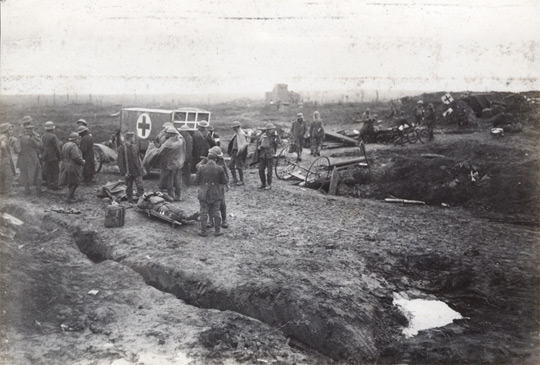Click on the photograph above to see a slide show of images showing New Zealand soldiers being cared for at an advanced dressing station, wounded being brought in by stretcher-bearers, and an ambulance being loaded at a casualty clearing station. The captions are those used in the original scrapbook from which these images are taken.
[T]hey were just laying around where they’d been dumped by the stretcher bearers from off the field and at one period I believe there were 600 stretcher cases laying round the place in the wet and cold, just dying there where they were dumped off. They weren’t even laying on stretchers, just laying on the ground with an oil sheet tied over them if anyone thought to do that, or if one of their mates could do it. Just laying there, because the stretchers were used for picking up other men, you see, there couldn’t be a stretcher for every stretcher case. We just carried till you couldn’t carry more. You just went until you couldn’t walk really, you just went until you couldn’t walk.
Taking wounded men off the battlefield was easier in theory than in practice. Between 4 and 13 October over 2600 men on stretchers were moved from the front line. Stretcher-bearers faced an almost impossible task of carrying these men to regimental aid posts, dressing stations and sometimes the distant casualty clearing stations.
It took stretcher-bearers three days to clear the field of wounded after the opening salvo of Passchendaele at Gravenstafel on 4 October. Four men would carry a stretcher the 3 miles to safety — a trip that took them about four hours.
The events at Passchendaele from 12 October were even worse for the wounded and those taking them to safety. Six men carrying a stretcher could take up to five hours to move the wounded to the nearest dressing station. Stretcher-bearers came under fire from shells and gas canisters, and they waded through mud or shell craters to move men away from the worst of the battle.
It is amazing the amount of reserve endurance that is stored in the human frame. Our rate of progress [to the battlefield] was a veritable crawl. We were verging on the condition of collapse. Our feet were just two concentrated lumps of pain — trench feet. The gas we had experienced…had affected our throats … our voices were a mere whisper. We did not have sufficient energy to hold up our heads and as we staggered back not a word was spoken, but possibly they all felt — as I felt — that if there was another patient waiting … I would just break down and cry. And there was another patient — three or four in fact! Ben Thorn, our leader…said ‘Come on boys, hoist him up’, and once again we staggered and fought with the clinging slime.
That trip was a nightmare. We would sink in the mud and our legs were so weak and shaky, it was becoming a matter of the most acute difficulty to get out. We had one consolation. We were so far gone as to be beyond caring and the shells which screeched down in close proximity were unheeded. We reached the Somme [a dressing station] — we had to reach there. Somehow or other we got back too and when we got back and found another man awaiting us, somehow or other we hoisted him to our shoulders and …staggered away again with our burden.
Private Linus Ryan, New Zealand Army Medical Corps, ‘My three years in khaki’, manuscript supplied courtesy of Anne Smyth
Safety in the dressing stations was relative. Some at Passchendaele provided little protection. Men lay in agony for days in the mud and rain; some died of exposure or were shelled while waiting for help.
At Waterloo Farm the situation was desperate. This long, ugly, grey mass of concrete, pierced with openings, so close to the ground that a man must crouch to crawl in, was packed with wounded, and yet more came in all day that had to be placed about the walls outside and in the rear of the structure, where they lay exposed to rain, bursting shells, and occasional machine gun bullets.
A. Carbery, The New Zealand Medical Service in the Great War 1914–1918, 1924
Extra stretcher-bearers were called in to move the injured from the Passchendaele battlefield. In the end, it took four days to clear the wounded — too late for many. New Zealander Margaret Davies nursed men from Passchendaele at a British hospital and recalled their condition even after they had passed through the various dressing stations: ‘the wounded were brought in in a dreadful condition. Solid masses of mud, it was so hard trying to get them out of their khaki, especially when the mud had had long enough to harden’.


Community contributions